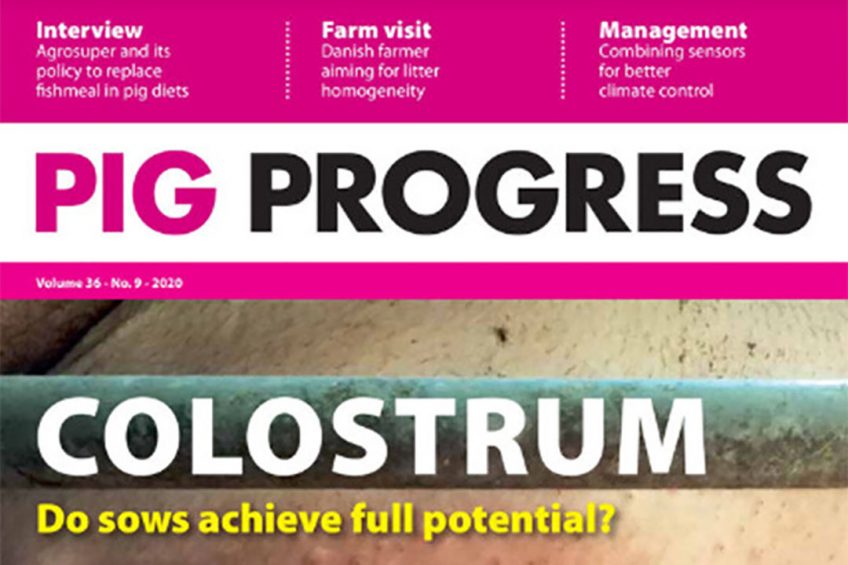Colostrum, cameras and construction in Pig Progress 9

The 9th magazine edition of Pig Progress is available for readers to access. Colostrum and the changing and challenging requirements of the sow are in the spotlight. Also in this edition is Agrosuper and its policy to replace fishmeal in pig diets, and a Danish farmer who aims for litter homogeneity.
View Pig Progress digital magazine
SwineTalks: Online insights on biosecurity
The new international, virtual swine event, SwineTalks, was held in October, with 29 experts presenting a wide variety of subjects in the swine sector to over 100 live participants. Pig Progress had front-row seats and homed in on respiratory health issues and biosecurity presentations. The full review from page 6.
Virtual SPACE: Five pig innovations awarded
Following the Innov’SPACE awards which took place in September, 5 useful swine innovations are under the spotlight in this article on page 10.

Weighing up the effect of parity and prolificacy
The EU PiG Innovation featured in this edition is the Kalinat approach, an online tool for breeders to assess the quality of a litter of piglets at birth, making it possible to determine the effect of parity and sow prolificacy on the mean birth weight. The details of this innovation can be read an article by correspondent Natalie Berkhout on page 12.
Being a farmer can be tough
This column features new columnist Irene Camerlink; she is an interdisciplinary researcher focusing on pig behaviour, welfare and production. She discusses Covid-19’s massive consequences on pigs and on farmers. “What makes the consequences of the pandemic so impactful is the combination of a lack of control along with the need to still take responsibility for a decision, along with the lack of recognition and lack of financial and social support,” she says. Her article on page 13 is food for thought.

Replacing fishmeal is not an easy challenge
Dr Wolfgang Peralta is head of swine feeding and nutrition at one of South America’s largest swine producers, Agrosuper. In interview by Pig Progress editor Vincent ter Beek as from page 14, he describes the solutions in starting to replace as much fishmeal as they can from post-weaning diets.
Aiming for higher litter homogeneity
Swine producer Søren Kjær Poulsen is among Denmark’s most successful DanBred breeders. With around 850 purebred sows, of which 160 are Landrace, he breeds around 26,000 piglets per year. Journalist Michael Werning of Germany’s pig title SUS contributed with an article on page 18 about his experienced staff and a new protein strategy that has resulted in top performance.

Germany’s plan to be ASF-free again
It was in September that African Swine Fever was detected in wild boar in Germany. Fighting the virus is mostly up to state and regional authorities, although neither farmers nor hunters are convinced the right approach has been taken. Senior reporter Kees van Dooren of Pig Progress’ sister title Boerderij shares the details as from page 22.
There is no need to rethink genetic selection
Is it time to fundamentally rethink genetic selection? That was the title of an article in Pig Progress 6. In a letter to the editor, Hans Olijslagers, CTO at breeding company, Topigs Norsvin, explains why that is not the case in his view on page 25. He discusses pre-weaning mortality, backfat and pork flavour, the cost of lameness, and hernias and other genetic defects.

Colostrum: Do sows achieve full potential?
Sows are exceptionally well equipped to provide colostrum and milk to their offspring. However, genetic progress in terms of sow prolificacy is changing the requirements of that valuable talent, writes genetics expert Marcello Marchesi. Read more on page 26.
Metabolomics: The missing link in genetic selection
Metabolomic selection can improve genetic gain in difficult-to-measure traits by combining whole metabolomic data with phenotypic, pedigree and genomic data. Metabolomic selection is an emerging breeding technology based on a new source of information, namely nuclear magnetic resonance (NMR) metabolomics. DanBred’s Helle Palmø discusses that at page 28.

Combining sensors for better climate control
Project PigSys addresses issues of outdated building standards, control systems and barn management by adopting a multidisciplinary approach to pig production. This way, as discussed as from page 30 by a group of German scientists, the project ensures that all aspects relevant to sustainable, socially acceptable and economically viable pig production systems are addressed.
Column: Do we need to refocus our attention?
Dr Casey Bradley, president of the Sunswine Group, discusses how in the US, the focus has been on slowing down pigs to reduce the cost of production. Meanwhile, other matters may need to be prioritised. Read more on page 34.
To read the full articles, simply click on the digital magazine section and then on Pig Progress 2020-9. Registration is free.











